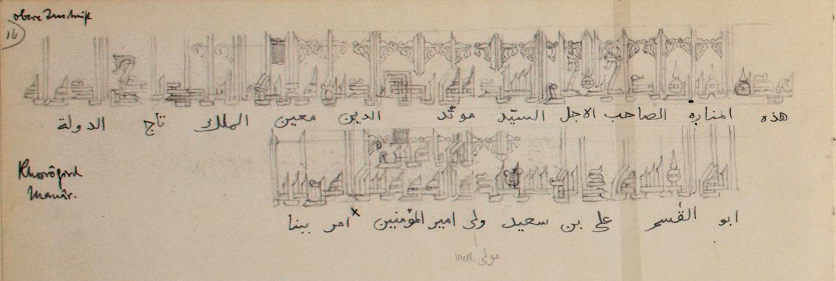So this is the Golden Road. Eight centuries ago, the minaret of Khosrugird watched the traffic as it watches us.
“What strikes the researcher, is the very scant information that one can find about the minaret.” This is what I wrote on a post-it while searching the web and the books for more information on the minaret Robert Byron saw on the 14th of November 1933, on his way to Nishapur.
On Archnet, the minaret is recorded with just one sentence: “Located outside of the city of Sabazevar in the historical city of Khusrawgird, this cylindrical brick minaret is thirty-eight meters tall.”

But if one does not give up, precious sources can be found to have a deeper look at this Seljuk minaret, dated 1111-1112. Based on the information I managed to find, I am writing this post, essentially as a start for further researches on the minaret. So, don’t take everything I write as pure gold: this post is much more a gathering of all my thoughts and notes on the minaret. And what I gathered so far, comes from one of the most valuable sources one can have: Ernst Herzfeld‘s sketchbooks.

The sketchbooks have been digitized by the Smithsonian Institution, and the sketchbook I’m basing on is recorded as Ernst Herzfeld Papers, Series 2: Sketchbooks; Subseries 2.03: Persia, Khorasan, 1925: Sketchbook 12. Particularly pages 16 and 17.
In these two pages, Herzfeld copies the two inscriptions that decorate the outer surface of the shaft, one in the middle, the other running in the lower part.

The upper inscription contains the information about the patron, transcribed by Herzfeld as follows:
أمر ببناء هذه المنارة الصاحب الأجل السيد مؤيد الدين [معين] الملك تاج الدولة أبو القاسم علي بن سعيد مولى أمير المؤمنين
Which I started to translate:
“The building of this minaret was ordered by the most exalted lord Mu’ayyad al-Din […] al-Mulk Taj al-Dawla Abu’l-Qasim Ali bin Said, Client of the Commander of the Faithful”
So far, I could not find any further info on the patron. To have some conclusions on the patron of the building (probably a local governor under the Seljuk ruler?) further studies should be undertaken.

The upper inscription, on the other hand, contains the Qur’anic text (part of Q 62:11), and the date:
وإذا رأوا تجارة أو لهوا انفضوا إليها وتركوك قائما قل ما عند الله خير من اللهو ومن التجارة والله خير الرازقين
في شهور سنة خمس وخمسمائة
Translated:
But when they saw a transaction or a diversion, [O Muhammad], they rushed to it and left you standing. Say, “What is with Allah is better than diversion and than a transaction, and Allah is the best of providers.”
In the months of the year 505 [1111-1112]

Probably we can see the reference to the date as being the continuation of the upper inscription, that lacks the reference to the year of construction, something quite unusual for a foundation text.

The Qur’anic inscription, even if it does not openly refer to the prayer, is taken from the Surah Jumu’ah (Friday), which is strictly connected with the Friday congregational prayer. It would have made sense to find this kind of context on a congregational mosque, instead of on a free-standing minaret.
The minaret, as commonly seen in Iran, was a way to mark the road, with a function similar to a lighthouse. Nonetheless, it is possible to argue that in this case, the patron wanted to underly the connection to the religion. On the other hand, it is interesting how the inscription clearly talks about diversions in the path of the believer and how God is the right guide. A sense that can be in turn connected to the function of the minaret as a lighthouse, a guide for the travelers.
Sources
The sources I have used are mentioned and linked in the article. Further photos on archnet.org.
2 Comments Add yours